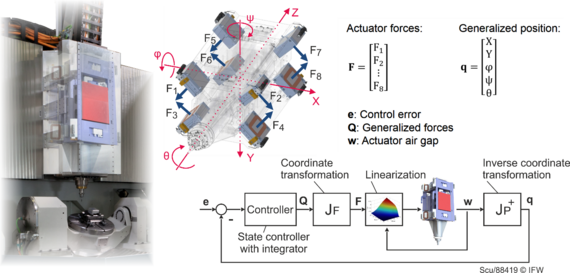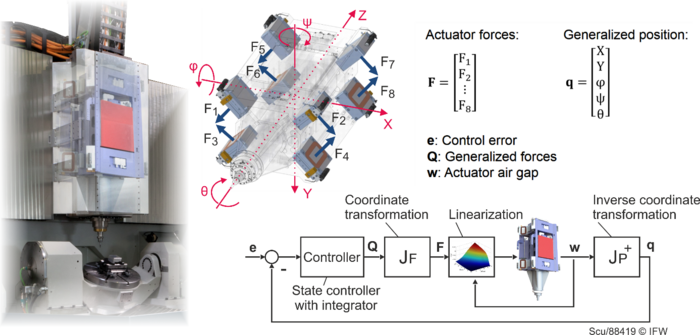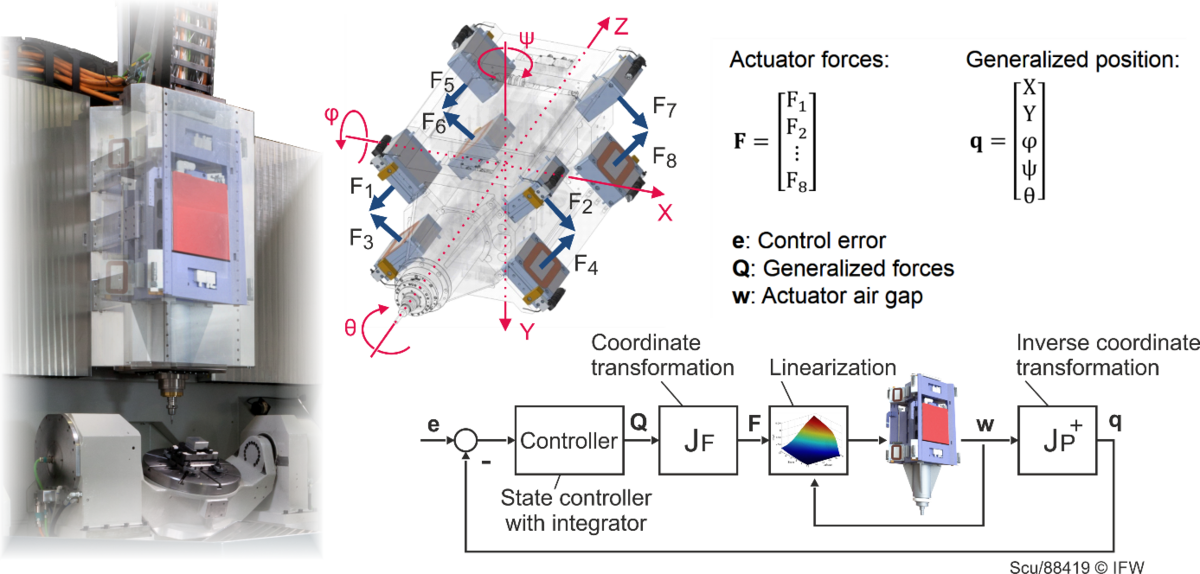Motivation and objectives



Complex repair components, such as tools for foundry and forming technology, components from aircraft engines or gas and steam turbines usually have free-form geometry features, individual material deposits and poor accessibility. The re-contouring of such components requires increased machine and process flexibility.
In subproject B2, a dexterous repair cell is being researched which represents the central component of the real regeneration path in the SFB 871. "Dexterousness" is understood as the ability to carry out a self-optimizing, best possible repair machining. The combination of novel machine functionalities and adapted cutting technologies enables the reliable 5-axis re-contouring of individual damage cases despite repair-specific variances, influences from upstream processes and flexibility of the workpiece or tool.
Please note that activating the video will result in the transfer of data to the respective provider. Further information can be found in our privacy policy.
Play video
The video shows the 5-axis re-contouring of a turbine blade, which was repaired at the tip.
Results
The prior work resulted in a machine demonstrator, which integrates the novel process technologies and machine functionalities. For the re-contouring of flexible and vibration-prone components, basic knowledge on tool selection, milling strategy and process control was developed and transferred to process planning. The suitability of electromagnetic guides for repair machining was evaluated. Methods for force reconstruction and control by means of electromagnetic guides were developed and applied to compensate for process force-related displacements. Critical process states can be detected and suppressed automatically during operation by adjusting the process parameters.



Current research and outlook
Minimizing shape deviations despite varying workpiece properties is the main objective of subproject B2. Methods will be developed to identify local variances during machining. Tracing back the variances and identifying the causes will lead to an enhanced process planning for upcoming repair cases. Therefore, the dexterous machine tool will be improved by increased sensory abilities as well as artificial intelligence. A self-learning process force model is being researched in order to enable a precise prognosis of the process forces despite the individuality of the repair cases and finally to identify variant-related deviations in the process. On the machine side, a control architecture is being researched that makes it possible to combine data from NC control, machine-integrated sensor technology and process simulation. This is the prerequisite for learning the force model and for identifying local workpiece variants. For predictive control, position-dependent control values must be determined from the identified variances. In cooperation with TP C1, measures for improved process control are derived and interactions with upstream and downstream machining steps are identified. In this way, the control interventions can be optimized with regard to the machining result. In addition, an intelligent workpiece carrier is being researched that has multifunctional sensors for process monitoring along the entire repair path.
Subproject leader
30823 Garbsen
Staff
Publications
International Scientific Journal Paper, peer-reviewed
-
(2021): Anticipatory Online Compensation of Tool Deflection Using a Priori Information from Process Planning., JMMP 5 (3), S. 90.
DOI: 10.3390/jmmp5030090 -
(2021): Identification of rake and flank face engagement parameters using a dexel-based material removal simulation with an oriented sweep volume., CIRP Journal of Manufacturing Science and Technology 35 (1), S. 146–157
DOI: 10.1016/j.cirpj.2021.06.002 -
(2018): Technology-based Re-contouring of Blade Integrated Disks After Weld Repair, J. of Materi Eng and Perform 27, 2018 (1), 253-260
DOI: 10.1115/1.4040738 -
(2015): Engine blade regeneration: a literature review on common technologies in terms of machining, Int J Adv Manuf Technol 81 (5-8), S. 917–924
DOI: 10.1007/s00170-015-7256-2 -
(2015): Analysis of Chatter Vibration and Tool Deflection in Milling with a Novel Active Machine Tool Guide, In: Applied Mechanics and Materials 794, S. 331–338
DOI: 10.4028/www.scientific.net/AMM.794.331 -
(2014): Evaluation of electromagnetic guides in machine tools, Cirp Annals 63, S. 357–360
DOI: 10.1016/j.cirp.2014.03.130 -
(2013): Adaptive Cutting Force Control with a Hybrid Axis System, International Journal of Automation Technology 7 (4), S. 379–384
International Conference Paper, peer-reviewed
-
(2019): Advanced process design for re-contouring using a time-domain dynamic material removal simulation., 12th CIRP Conference on Intelligent Computation in Manufacturing Engineering (Hg.): Procedia CIRP 79 (2019), S. 21–26.
DOI: 10.1016/j.procir.2019.02.005 -
(2018): Ball end milling of titanium TIG weld material and the effect of SiC addition – process forces and shape deviations, 6th International Conference on Through-life Engineering Services, TESConf 2017. 7-8 November 2017, Bremen, Germany, Seite 74-81
DOI: 10.1016/j.promfg.2018.01.011 -
(2014): Conceptual Design for Electromagnetic Guided Rotary Table in Machine Tools, Procedia CIRP 24, S. 80–85
DOI: 10.1016/j.procir.2014.08.010 -
(2012): Adaptive Cutting Force Control on a Milling Machine with Hybrid Axis Configuration, Procedia CIRP 4, S. 109–114
DOI: 10.1016/j.procir.2012.10.020 -
(2010): Multi-sensor Disturbance Force Measurement for Compliant Mechanical Structures, 9th Annual IEEE Conference on Sensors, S. 2518–2524
DOI: 10.1109/ICSENS.2010.5690446
International Conference Paper, not peer-reviewed
-
(2019): Improving Blade Re-contouring Processes Using an Advanced Process Simulation And a Novel Machine Tool, Advanced Manufacturing & Repair for Gas Turbines (AMRGT). ASME. Berlin
-
(2015): Mistuning of Blisks During Milling Process - Manufacturing and Repair, In: Deutsche Gesellschaft für Luft- und Raumfahrt (Hg.): Deutscher Luft- und Raumfahrtkongress (DLRK)
National Scientific Journal Paper, peer-reviewed
-
(2013): Bauteilregeneration bei einkristalliner Gefügestruktur, Werkstattstechnik online 103 (6), S. 476–480
-
(2012): Messtechnische Analyse formflexibler Spannmethoden, wt Werkstattstechnik online 102 (11), S. 795–800
National Scientific Journal Paper, not peer-reviewed
-
(2021): Abdrängungsausgleich mittels elektromagnetischer Führungen, mav - Innovation in der spanenden Fertigung, Bd. 10, S. 84–87
-
(2020): Magnetische Führungssysteme optimieren die Zerspanung, MM-Maschinenmarkt, 126-17, S. 75–79
-
(2020): Optimierte Zerspanung: magnetische Führung., Schweizer Maschinenmarkt (SMM), Bd. 20, S. 45–58.
-
(2019): Kompensation der Abdrängung beim Rekonturieren von Triebwerksschaufeln, Ingenieurspiegel Ausgabe März, S. 20–22
-
(2011): Den Exoten auf der Spur: Anwendungsgerechte Zerspanung von Leichtbauwerkstoffen, WB Werkstatt + Betrieb 2011 (9), S. 60–64
National Conference Paper, not peer-reviewed
-
(2014): Potentiale elektromagnetischer Linearführungen in Werkzeugmaschinen, ZWF 109, S. 625–628
-
(2012): Dexterous Regeneration Cell for the Repair of Aircraft Engine Components, Neue Fertigungstechnologien der Luft- und Raumfahrt. Universität Hannover, I. F.W. Hannover, 01.01.2012
Dissertationen
-
(2017): Potentiale einer elektromagnetischen Führung in Fräsmaschinen und ihr Nutzen für die Reparaturbearbeitung, Berichte aus dem IFW, Band 03/2017, 145 S., PZH Produktionstechnisches Zentrum
ISBN: 978-3-95900-126-7 -
(2014): Erweiterungen der Einsatzmöglichkeiten von Magnetführungen, Berichte aus dem IFW, Band 05/2014, PZH, Garbsen, 2014
ISBN: 978-3-944586-71-7




